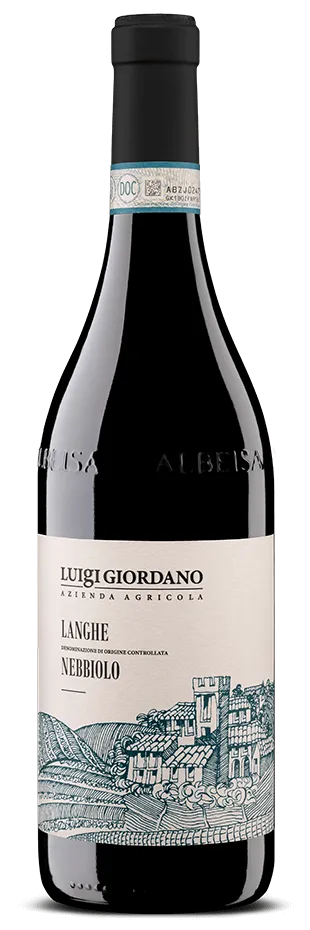Luigi Giordano
Barbaresco, Piedmont
Not far from the centre of Barbaresco, among the hills that border the sinuous Tanaro river, the Luigi Giordano estate was founded by Giovanni Giordano in the 1930s. The Italian wine world was going through profound changes and challenges then. So, after having grown and sold grapes for most of the estate’s existence, Giovani’s son, Luigi decided to vinify the grapes himself from 1960. His decision to highlight the potential of the terroir and go down the path of quality winemaking paved the way for many other Barbaresco producers of his time.
Today, it’s the only fifth-generation winery owning vineyards planted in some of Barbaresco’s most prestigious crus, including Asili and Montestefano, and Cavanna. The Cavanna cru epitomises Luigi Giordano’s hands-off winemaking style and constitutes the only (a monopole) single-vineyard cru of its kind on the market.
It boasts over 7 hectares of vineyards, most of which are dedicated to “denominazione di origine” status Barbaresco. Luigi’s grandson and now custodian, Matteo Rocca, cultivates traditional local varieties. You’ll find the noble Nebbiolo, its generous counterparts, Dolcetto and Barbera, along with Freisa and more recently Arneis, the only white and one of the most popular Piedmontese whites on the international wine scene.
Matteo’s ambition is guided by a deep respect for his grandfather’s elegant and loyally traditional style. Long maceration time on skins and maturation in large botti are the defining features of wines that gain in definition and detail every year, continuing to honour the impressive sites they hail from.
2023 Vino Rosso
The fruit comes from various parts of Luigi Giordano’s plots. The Vino Rosso is a blend of indigenous grapes.
Winemaking:
80% Nebbiolo, 20% Roero Arneis co-fermeneted. Low maceration (4-5 days) to preserve the freshness of the wine.
Tasting Notes:
A Nebbiolo dominant blend, this wine is light, lithe and refreshing. It’s made of a super unique blend including 20% Roero Arneis, which adds aromatics and lift to the wine, softening the tannins. This brilliantly easy-drinking, chillable red, is translucent ruby in the glass, filled with ripe strawberry, red cherry, fleshy peach characters, and dried rose petals, the Nebbiolo signature feature.
2020 Langhe Freisa
The fruit comes from the subzone of Valle dei Salici (meaning “valley of willows”) situated at the heart of Barbaresco in the Cars vineyard.
Winemaking:
The fruit comes from the subzone of Valle dei Salici (meaning “valley of willows”) situated at the heart of Barbaresco in the Cars vineyard.
Tasting Notes:
Here’s a tantalising wine boasting an incredibly intense nose filled with notes of maraschino cherry, spiced plum, sun-dried tomato and dried herbs. The palate is as savoury and intense, with drying, rustic tannins peppered through the rhubarb and sour plum characters, the lot culminating in a long, chalky finish.
2022 Langhe Nebbiolo
Giordano 's Nebbiolo Langhe is produced with grapes from different vineyards (Carlinet, Buschet, Ronchi and Cavanna).
Winemaking:
The fruit was gently destemmed, and the juice was macerated on skins for 15 to 20 days with frequent pumping over to preserve fresh aromas and extract colour. It was naturally fermented in stainless steel tank. After malolactic conversion, the wine was aged in a combination of stainless steel and concrete tanks for 12 months.
Tasting Notes:
“Red fruits, new leather, sage, a little spice, slight smokiness. Medium-bodied, strawberry and dried herb, fresh acidity, a fine bony crunch to tannin, slight almond and sage/dried herb on a finish of good length. Finely wrought and not trying too hard, which I love. It’s a delightful, brisk style of Nebbiolo that drinks a charm.” - Gary Walsh, The Wine Front
2021 Barbaresco ‘Cavanna’
Cavanna is a historical cru located directly under the tower of Barbaresco. It’s the closest sub-area to its centre. Other prestigious producers the likes of Gaja, Moccagatta, and De Forville grow grapes for their finest Barbaresco there. The exposure goes from West to South-West and the soil is composed of Sant'Agata fossil marls and silt. The vineyard, planted between 1988 and 2006, is divided into 3 sections overlooking the Tanaro river, which creates the unique microclimatic conditions that make it their most prized vineyard: it was the first to be vinified as a single vineyard by Luigi in 1971 and, since then, they are the only ones to claim its name on the Luigi Giordano label.
Winemaking:
After gentle destemming, the fruit was macerated on skins for 15 to 20 days and fermented in stainless steel tanks. The wine was aged for 18 to 24 months in large 30-50 hL Slavonian oak, followed by 6 months in bottle.
Tasting Notes:
“Aromas burst forth with a medley of freshly milled sweet, picante, and savory spices, creating an enticing bouquet. Warmed roses mingle with the freshness of raspberries, accented by hints of wild herbs. The nose is so aromatic that one might get lost before even taking a sip. On the palate, this wine is generous and inviting, with notes of tart cherries and fresh currants dancing across the tongue. Subtle hints of tea and earth add complexity to the finish, which is framed by elegant and fine tannins.” - Jeff Porter, Wine Enthusiast
2021 Barbaresco ‘Asili’
Asili is arguably the most important single vineyard in all Barbaresco. It’s celebrated by Bruno Giacosa and Ceretto as the source of fruit for their top wines. The vineyard, planted in 2000, is South-West facing.
Winemaking:
After gentle destemming, the fruit was macerated on skins for 15 to 20 days and fermented in stainless steel tanks. The wine was aged for 18 to 24 months in large 30-50 hL Slavonian oak, followed by 6 months in bottle.
Tasting Notes:
“This Barbaresco is a real head-turner, with an irresistible nose of fresh roses and juicy red fruits that'll keep you coming back for more. The palate is smooth and easy-going, packed with cherry and raspberry flavours, and the tannins are so well-behaved you won't even notice them. Enjoy it now or let it age – either way, it's a winner.” - Jeff Porter, Wine Enthusiast
2021 Barbaresco ‘Montestefano’
Giordano owns the only parcel of Montestefano with a South exposition. It’s also the highest parcel.. It's also worth noting that Montestefano and Montefico are the two most important vineyards situated on the eastern flank of Barbaresco. The vineyard, planted in 1979, is South-facing.
Winemaking:
After gentle destemming, the fruit was macerated on skins for 15 to 20 days and fermented in stainless steel tanks. The wine was aged for 18 to 24 months in large 30-50 hL Slavonian oak, followed by 12 months in bottle.
Tasting Notes:
It’s enticing and highly aromatic with a rich fruit core of black cherry and strawberry with notes of cinnamon, allspice, and earthy notes of truffle. The palate is firm with a fine tannin structure, fresh acidity, and a long-lasting taste.













